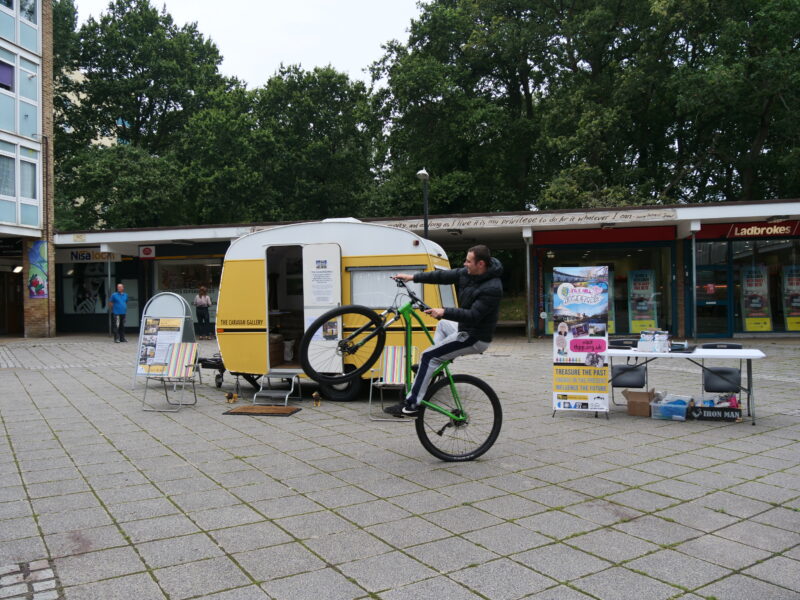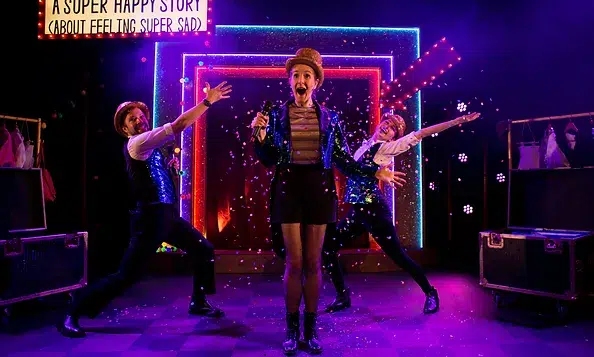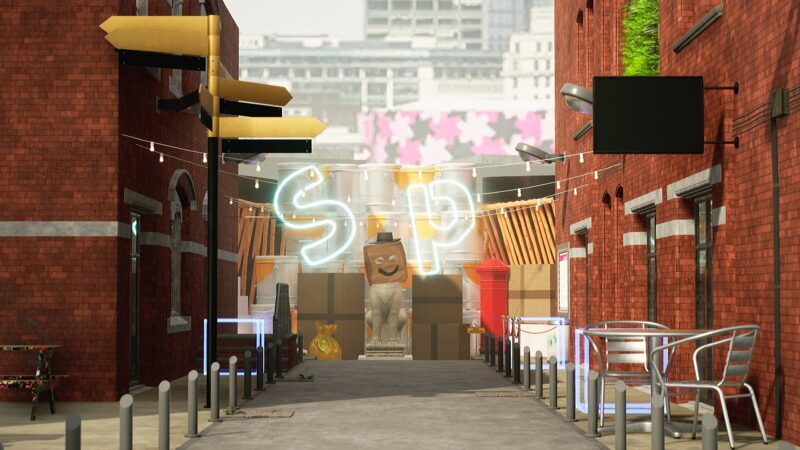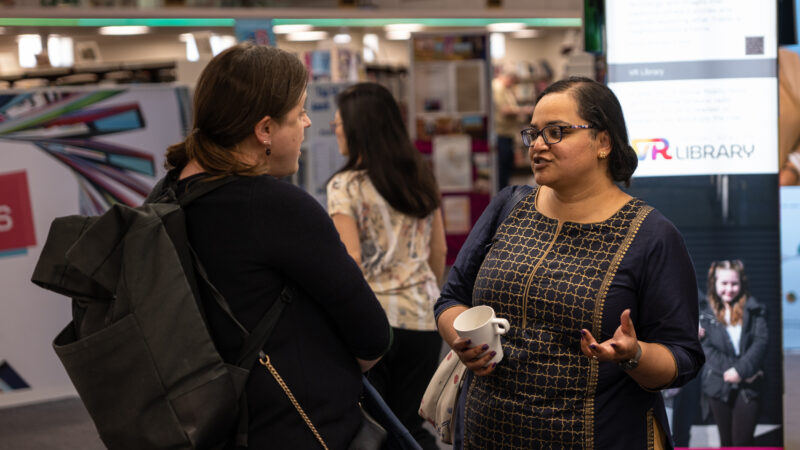Conversations and advice
In our latest podcasts, we are looking at the way artists and organisations can use digital when working with communities.
The appetite for working with communities, rather than for them is becoming ever more important. Let’s Create, ACE’s 10-year strategy, prioritises inclusivity and relevancy as a core principle, with the aim of delivering greater access, fairness and opportunity for everyone.
In these ‘cup of tea conversations’ we speak to artists and organisations whose work has community at heart and discuss what makes their approach successful, how they use digital, and how the work is evolving. Each episode lasts around 20 minutes and takes the form of a conversation over a lovely cuppa.
Below is a transcript for the first of these conversations with Jan Williams from the Caravan Gallery.
Jan Williams, The Caravan Gallery
Jan Williams, along with partner Chris, runs The Caravan Gallery which records the reality and surreality of everyday life. She explains how they embed themselves within communities and how they build strong connections within the communities in which they work.

Speakers
Jan Williams (Caravan Gallery), Rob Lindsay (Head of Programmes, The Space), Clare Freeman (Podcast Producer)
Clare Freeman 0:02
Hello, I’m Claire. Welcome to a brand new series of The Space arts podcast series where we delve a little deeper into the lessons learned and challenges that come with producing art digitally. Our next six episodes, each long enough for a sit down with a hot drink, offer a unique insight into artist community collaboration, distribution, and broadcast commissioning. The conversations you’ll be hearing are taken from our recent webinar series, which you can also watch in full online, visit the space.org or read the episode description to find out more. First up we have Jan Williams from the Caravan Gallery who with her partner in crime, Chris Teesdale, quite literally tours a little yellow caravan around the country. Together, they’ve created an alternative tourist centre on wheels. They celebrate and connect local people through their creative ventures and artwork. But how do artists engage with local communities without feeling like they’ve parachuted in? Let’s have a listen. Pop that kettle on and enjoy the first of our cup of tea conversations. I’ll hand over the hosting reins to my trusted colleague Rob Lindsay, Head of Programmes at The Space. Jan kicks off by explaining what on earth it is they do and how it all started.
Jan Williams 1:34
Caravan started out in the year 2000. We have a studio in Art Space Portsmouth and there was a call out for a socially-engaged project to go into the community. It was for the bank holiday weekend, in the Millennium August bank holiday. So we won the commission, Chris and I, we went in search of a mobile exhibition space that would be good to take our artwork to where people are, down on the seafront. I was making a lot of work at the time, collage photography, drawing, whatever, about leisure landscape and lifestyle about everyday life. So it seemed like a perfect – literally – a vehicle to display that work. And so we made an exhibition in this caravan we ended up with, it came from Hayling Island, we gutted it out, we kept the original floral brown upholstery. But the rest of it became like a white cube. And it was really important to us to make it look kind of, it was kind of, quite cute and accessible on the outside. But once you got in, you could understand that, you know, we’re kind of proper committed artists. There’s a lot of humour in our work, because we find that’s a really good way to kind of cut through and deal with some really quite, you know, deeper things. But basically, that was a really fantastic weekend, we were absolutely mobbed by people. And it was just joyous, that interaction with people. Now at that time, a lot of our work was just about my partner Chris and I, Mr Caravan Gallery, it was about showing our own work. But people’s response to what we showed, showed there’s a real thirst for people to join in. They were saying, you know, there’s a lot of…the photographs brought about lots of conversations and questions. And we were thinking, how do we capture this? How do we use this? So since that time, when you think that weekend, it was meant to be a one-off bank holiday weekend in the year 2000…what year is it now?…we’re still going, doing something right! So we just kind of forged our own paths really, our approach is let’s just try things and see if they work. And we’re very flexible and adaptable. We kind of fit into any situation, any space. And we love the way that with the caravan it can, one minute you know, it can be on a seafront and the next minute it can be outside a betting shop in Norris Green in Liverpool, another time it can cheekily make its way into documentary in a castle. So it’s this kind of mixture of high and low. In the things, in the stuff we do. And the things we photograph and the things…we kind of feel everything connects, in all the projects we do, it’s about connecting people and things and subject matter and acknowledging difference, but looking at points of connection.
Rob Lindsay 4:44
That’s amazing. That’s amazing. And I know that, as you say, you can fit into lots of different spaces, you do tour all around the country as well. It must feel that you’re constantly building new communities and at the same time maybe having to start from scratch each time. Go in and meet new people, introduce yourselves to new people. And let’s not forget, existing physical communities you know, you’re in locations and there are communities there as well. Can I just ask what that involves, really? And yeah, what those communities are like?
Jan Williams 5:15
A lot of groundwork. We’ve done so many commissions where we’ve made lifelong friends and brilliant connections. And, you know, we sustain those relationships with people we meet. Aberdeenshire Ways was with Deveron Projects, in Huntley in Aberdeenshire. And we really love their ethos, because at the time we worked with them, they didn’t have a physical space, they just said the town is the venue. And so all artists who work there, they leave a piece of work behind that becomes part of the town collection. So it can be up at a butcher’s, the baker’s the garage. We had an exhibition on a bus shelter, and a washing line gallery in the square in a marketplace. So with a project like that, I mean, that had such a strong sense of identity, some of the older people spoke Doric, which is a language we didn’t even know existed. I think we’re in a really privileged position with the Caravan Gallery, because even though we’re commissioned by people, we’re free agents, we’re not the council, we are asked to work for and with organisations, but we’re artists, and we’re kind of conduits. And we have found a way of bringing people together who would never normally have any kind of social interaction, because their paths, their lives are just so very different. I think the gimmick, actually, of having a yellow caravan, you know, people just can’t resist going, “What is it? What’s in there?”
Rob Lindsay 6:51
I’m very interested if there’s ever any, and this touches on what we’ve talked about the other day, if there’s ever any cynicism from the public, how do you actually explain your work to them? And I suppose to chat a little bit about the language that you use to describe it to people as well.
Jan Williams 7:07
The most cynicism we hear is about a lot of the places we work in tend to be places that are economically not very well off. So there’s a lot of cynicism from people about stuff like regeneration, and ‘them’ and ‘they’ in the council. But we do these surveys, they’re not like boring surveys, they’re just quite off the wall some of the time, but it’s genuinely asking people what they think. And they can come in and have a moan, some people just come in to complain about parking or dog muck or whatever. And the council, usually. I think we try to show quite a balanced view of places, some people will look at our photos and go, “ugh, why have you photographed that?” you know, “there’s a thatched cottage, down the road!” And we say…we’re just kind of…when we go to a place we’ll scour every square inch, we’ll walk round, drive round, photograph, and just kind of get a feel for what we’ve observed. And that’s a starting point for conversations. So the subject matter that comes up, people might be quite cynical about, you know, “uh yeah, but you know what that’s for,” and, “that’s never gonna work.” But I think we are just utterly and completely honest and open with people. It’s difficult if you get someone, maybe, who has really racist views. And we have to be really careful not to shove our views down other people’s necks because I think it’s our role to listen, but we wouldn’t, you know, we would challenge toxic views. Of course we would. Or we find maybe the best thing is to gently say, “oh, do you think so? Well, we wouldn’t agree.” I think people see when when we talk to them in really plain language, no jargon, just saying, “well, you know, we photographed that because we wondered what it was. Can you tell us?” It’s a portal, it’s a way into a conversation. And I think it’s up to people to make their own judgments about things, but we’re just trying to bring about…trying to make people look and see and respond.
Rob Lindsay 9:17
I really love the idea that you’ve got this, you’ve got this fantastic bright yellow caravan that can just rock up in someone’s town or village or, you know, wherever it is.
Jan Williams 9:26
And it was that simple? There’s bollards…health and safety…[Rob laughs]
Rob Lindsay 9:34
But you’ve got something there that is, I would say quite an iconic physical item that can appear. But at the same time, and that is very much you guys, but at the same time, the art that’s at the centre of all of this, there is ownership to the communities that you’re moving into, you know, and particularly those conversations that take place afterwards as well. I’ll share this with the group, a little behind the scenes secret. When you and I were setting up a call even to have a sort of chat about your work, as some preparation, ahead of this webinar, you did have to say, “we are open. So at any moment, people could turn up, people might come in,” you know, and you’re there to have…
Jan Williams 10:11
Dogs! There’s always dogs coming in!
Rob Lindsay 10:13
And just for that, that kind of openness, and that presence, I think it’s something that is very important with communities. You talked about footfall being a huge driving force as well. I wonder if I could ask you to talk a little bit more about that.
Jan Williams 10:30
Yeah, so the caravan, it’s become increasingly our calling card. At one time, it was, you know, the main focus of what we did was in the caravan. And so for example, one of our favourite jobs ever in the Black Country, for Blast Festival with Multi Story, so that was a major major project, which resulted in a six week exhibition in a former Poundland in West Bromwich. So we took over the whole place. And there were a couple of other amazing photographers that had a smaller part of the building. But basically, we think about kind of co-created exhibitions as evolving explorations of place with the people of the place. And so we have a basic framework, we have a kind of formula that we adapt to where we are. And it’s just great because you just don’t know what’s going to happen next, and who’s going to walk in through that door. So we kind of think of them like alternative Tourist Information Centres, but made by the people. So we would start off with some of our photos just to get the ball rolling. So you know, when people go in, they can look and talk. We make these great big maps, that’s one of our favourite things, a big hand-drawn map that we ask people to annotate with…ghost sightings often appear on them! It could be where people found a tenner, really obscure things about mystical rain, and then, you know, some people put really sensible, kind of serious, studious facts and information on there, and other people just want to make their mark to show that they exist, really. And where they fell in the canal in the cut was a big thing in the Black Country. What was so absolutely brilliant was the conversations people had in front of this map, because it was a really massive one. There’d be people writing something on and then the person next to them would say, “did you used to go, you went to school there too?” and then they’d have a conversation and find out they were cousins or something. And then it’s just kind of never quite knowing…you have to…it’s absolutely exhausting because in an area with high footfall, where we always try to do these projects, you know, there’s just constant activity and you’re having to manage, like, you know, someone homelesses has come in, who might be a little bit drunken in front of kids that are in. And then someone with mobility issues who needs support. Just a whole lot of…you have to really spread yourself all over the place, and ideally, have a really good team of volunteers, helpers. Importantly, local ambassadors. Quite often we find someone who’s come along to kind of look at the project will be part of it, gets so involved, that they just want to, they never want it to stop. And they just stay there and they become self-appointed volunteers. And that’s brilliant. Because if you have local people on side, that really helps with the kind of trust thing. It’s not just people coming in from the outside, and then sodding off, and you know, [being] properly, properly embedded.
Rob Lindsay 13:51
Yeah, that’s fantastic. There were a couple of questions that people sent in advance. And there are two in particular, that jumped out that I wanted to put to you, if it’s alright, Jan. I’m gonna join these together, because I think they might be part of the same, part of the same approach. It’s about sort of getting started with community activity. So someone had said, as a small organisation, with very limited man hours, we’re interested in how you successfully isolate what the local community requires, and then deliver it without falling into a sort of tokenism of community engagement, in inverted commas. That may happen with all good intentions. So, that idea of identify what is it that your community needs, how do you go about doing that? And how do you go about delivering it? And then someone had asked a related question asking about the kinds of activities you can run to start engaging in community. So again, that kind of beginning approach – first ideas for reaching out and establishing what your community needs. Can ask you a bit about that? Because you do that every single time you arrive in a new city.
Jan Williams 14:50
We do. Well, I think it’s really important…you get the best results from the best preparation, like doing a reccy, you’ve got to get to know the place. So, we would usually go and have a week just roaming around, just talking to people, we’d go around with our cameras, photographing stuff. So that would be the very first thing, and just trying to fix up a few meetings, go to community organisations, go to libraries, go to clubs, just go to where people are. And so really try and get a feel for the place. And then very often the organisation or gallery, museum, library, whatever, who’s commissioned us, we have conversations. They would usually have some kind of priority, like, you know, we’re struggling to reach this community. So we would come up with strategies. With the caravan, for example, we can take it, you know…people go on about ‘no-go’ communities or, “no, you don’t want to go there.” So we said, “okay, right, let’s go there then!” I think if you make friends with caretakers, cleaners, road sweepers, not gonna say traffic wardens (laughs). I suppose we could do really! Just be friendly, talk to people, spend time in the place, you know, you just have to really put yourself out there. And then there’s different phases, maybe we’d get back to the studio and then there’s all this massive stuff like huge loads of photos, conversations, things to absorb. And then I suppose it’s about building connections with some of those people, following up, and taking an interest. And, you know, we might go along to meetings about allotments or community gardens. There’s an awful lot to do, obviously, with poverty, food poverty. So we might go along to food pantries. We found working in Tile Hill that the church is a massive part of the community. And they provide a lot of services along with the library that, you know, you might expect the Council or Social Services to do. And another thing is isolation is a massive issue we come across, people just want somewhere to come and hang out. I know I’m deviating slightly here. But I just think it’s a really important thing to say in society today, we come across so many people struggling with their mental health. And I think just creating a place, an environment where people can just come and be and be listened to and to share, to be heard, really, because a lot of people just feel overlooked. And no one cares about what they think. So if we can celebrate things that they do – we always have a creative area like with, you know, paper collage stuff. We do creative walks, we just arrange programmes of stuff, depending on where we are. So people can just join in. And very often they go, “oh, no, you wouldn’t, you know, I can’t do anything,” so [we say] just come and have a cup of tea, just come and hang out. And then before they know it, they’re doing something. And that’s a really important aspect of it, just kind of, we can go in and identify very often what’s missing in the community, by what people tell us. We know what they want that isn’t there. So quite often, we can present that back to whoever we’re working with, to say, you know, people really want somewhere like this permanently.
Rob Lindsay 18:29
Yes, yes. And that must be incredibly creatively nourishing as well. I’m sure going out and having those conversations, it must be generating more ideas, or more, you know, more inspiration than you could ever possibly deliver on.
Jan Williams 18:42
That’s another important point I wanted to say as well, you know, the idea of not this parachuting in business, we’re very, very careful that we, I mean, it’s inevitable that, you know, if you go in from outside, you will have different things to add. But it’s just kind of, it’s really important, it’s crucial to see what’s already there. Because we see in lots of places, organisations in a place, don’t connect with each other. They’re all busy doing things, them over there, them over there, they don’t talk to each other. So we like to find out the good things or what’s already happening and highlight it, just kind of, you know, give it some kind of platform. So if there’s someone beavering away in their shed making something, but no one’s seen it, if there’s an art project that happened a couple of years ago and it didn’t really get much coverage. Quite often we introduce people to each other that we’ve met in our project [they say], “I want to get together with them. They know how to do that.” So it’s just about connecting in a massive way and celebrating what’s already there and helping to build it and maybe trying to initiate and support people who maybe as a result of our projects want to start something, then we can mentor them.
Rob Lindsay 20:06
And if I can ask you just to tell us where can people find you? If they want to hear more from you, where’s the best place to find your work?
Jan Williams 20:14
Have a look on our website. So I’ll put the address…it’s www.thecaravangallery.co.uk. Yeah, well, thanks for having me.
Rob Lindsay 20:26
No problem at all. Thank you very much.
Clare Freeman 20:28
A joy to hear Jan talk so passionately about her work. And I’ve worked with Jan as part of our Digital Spaces Presents commission with Coventry libraries. I saw their great work in the community firsthand. Have a listen to a podcast series called Digital Spaces Presents where there’s an episode all about their Tile Hill Pride of Place project. And hey, our thanks to you for listening to this podcast. Hope you’ve enjoyed this pause in your day. A little gentle reminder that if you’re an arts and cultural type who needs a bit of support, then go visit the website www.thespace.org. There’s webinars, resources, toolkits, and potentially commissioning opportunities – ready to go at the tap of your fingers. And when you’re ready for your next cup of tea, there’s plenty more episodes in this series for you to hit play whenever you need them. Bye for now.
How useful was this resource?




